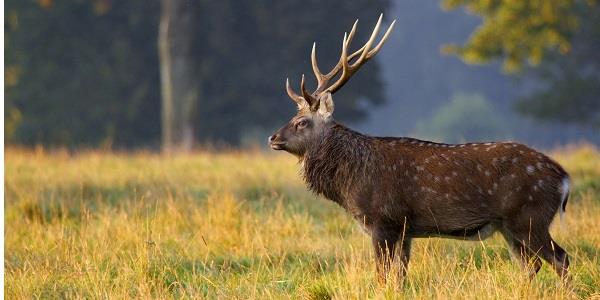
The Peak District is a great choice for wildlife lovers. With its unspoilt landscapes, diverse environments and careful conservation efforts, it’s a fantastic place for many species to thrive.
Holidaymakers staying at Blore Hall will find plenty to keep an eye out for during their visit. After all, the National Park covers a huge area of 555 square miles, so there's plenty of opportunity to meet some of the locals! From tiny voles and bumblebees to majestic Red Deer, you’ll be amazed at how many animals you’ll start to notice.
To make sure your explorations get off to a good start, we’ve pulled together a list of six of the Peak District’s animal residents. Keep an eye out during your days exploring and there’s a good chance you’ll spot a few of them amongst this fantastic region of the UK.
Mountain Hare
Before being introduced to the Peak District in the 19th Century, Mountain Hares were native to the highlands of Scotland. They do not dig burrows, instead sheltering in shallow depressions in the ground called ‘forms’. Famously, the Hare’s naturally brown coats turn white in the winter, camouflaging them more efficiently against predators. This means they are most visible in Spring, when the snow has melted but they still have their winter coats – see if you can spot them zig-zagging through the heather!

These protected creatures thrive in areas of mixed heather and cottongrass moorland and prefer to live around boulders, which provide plenty of good hiding spaces. Unfortunately, the species has recently vanished from some areas of the moorland, including Eyam Moor and the South West Peak, but Hares can still be seen between Derwent Edge and Outer Edge in the Dark Peak.
Short Eared Owl
This medium-sized owl can be seen all year round in the upland moorlands of the park, where the open moorland, bogs and grassland provide sufficient cover for their nests. Short-eared owls (or “shorties”) can sometimes be seen hunting small mammals such as voles during the day and can be recognised by their short ‘ear tufts’, mottled yellow and brown back and paler underneath.

The Peak District Moors Special Protection Area (SPA) is a European designation for its populations of merlin, golden plover and short-eared owl. Working locally with land managers and birdwatching groups, there is a huge focus on maintaining the bird’s habitat and encouraging more mating pairs in the area.
Red Grouse
This year-round resident of the Peak District is a familiar sight among the heather moors and blanket bogs throughout the park. With its plump, red-ginger body, it’s an unmistakable sight in the Peak District – it was made even more recognisable by the ‘Famous Grouse’ which appears on whiskey bottles! Sadly, the UK population is in decline, perhaps due to the loss of their habitat (the UK contains three quarters of the world's heather moorland), so the species was added to the UK BAP (Biodiversity Action Plan) list in 2007.

Willow Tit
Willow Tits can be seen at Old Moor, Willow Carr or on the Easter Moors, all year round. These little birds are found exclusively in wet woodlands and willow thickets and love damp environments such as marshes and peat bogs. They nest in the cavities of dead trees or tree stumps and survive on insects during breeding season before switching to seeds and berries in autumn and winter.

Willow tits have suffered a major decline in recent years, possibly due to changes in woodland management, and it have therefore become a target species in the Forestry Commissions woodland birds project.
Water Vole
Water voles were once Britain’s largest declining mammal, but now have a stable population in the Peak District. Often found in rivers and streams, they’re very similar in appearance to rats, although Water voles have shorter features and rounder ears. Make sure to listen out for a distinctive ‘plop’ when walking past streams and rivers – it could very well be one of these furry creatures escaping to its burrow!

There is a great deal of conservation taking place to help maintain the population of water voles, which are under threat by the non-native American mink. This includes maintaining their natural refuges, carefully surveying and monitoring their numbers and encouraging food and cover for the animals through careful land planning and management.
Red Deer
The Sheffield Moors are home to a herd of over 170 red deer. Completely wild, they roam freely throughout the area and have been sighted as far away as the Burbage Valley. They are the largest land mammal in the UK, with stags (males) reaching up to 130 cm at the shoulder and weighing up to 240 kg. You can recognise the stags by their spectacular antlers, while hinds (females) are smaller. The females are very territorial and the large herd tends to stay on Big Moor, with the stags re-joining them in September to mate.

The Peak District is famous for its dedication to wildlife conservation. With 54 sites of Special Scientific Interest, covering 50,000 hectares, charities, organisations and landowners work together to improve and maintain these important habitats. To find out more about the work done in the Peaks, and how you can support it, visit their website.
Fantastically located in the heart of the Peak District itself, Blore Hall is the perfect place from which to experience this spectacular part of the UK. Enjoy easy access to some stunning walking and cycling routes and lose yourself in the beauty of your surroundings. When you’ve had your fill, return to your comfortable holiday accommodation to relax and unwind.
Find out more about how you can stay at Blore Hall, as well as our many other properties, here.

